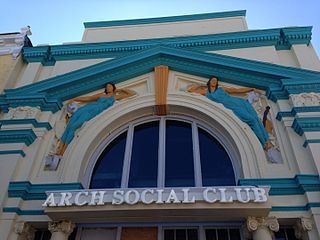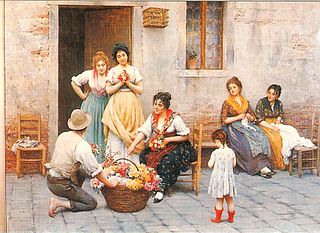Related Research Articles
Harborview is a waterfront community located in Baltimore, Maryland, United States. The community sits at the eastern base of the Federal Hill neighborhood in a former industrial area, occupied mainly by shipyards.
SS Pedernales was a lake tanker of the World War II and post war eras. She was built in 1938 in Monfalcone, Italy, and sailed under the British flag. Pedernales was severely damaged in a torpedo attack on 16 February 1942 while anchored at Aruba.

The Baltimore–Columbia–Towson Metropolitan Statistical Area, also known as Central Maryland, is a metropolitan statistical area (MSA) in Maryland as defined by the United States Office of Management and Budget (OMB). It is part of the larger Washington–Baltimore combined statistical area. As of 2022, the combined population of the seven counties is 2,985,871, making it the 20th-largest metropolitan statistical area in the nation.
Loch Raven is a neighborhood extending from northeast Baltimore City to the eastern part of Baltimore County, Maryland. The major road in the neighborhood is Loch Raven Boulevard, which stretches all the way from the I-695 beltway in Baltimore County to 25th Street in Baltimore City. It is located in the Baltimore Metro Area, and is considered one of the longest roads in the area with many different aspects of Baltimore that can be seen by riding through the area. This region is a diverse, but predominantly African American part of the city and county, and is also the area that consists of a large amount of Morgan State University students. The zip codes assigned to this area are 21218, 21239, 21286, 21284, and 21234, which is also a Parkville zip code.
Cedonia is a region of Northeastern Baltimore, Maryland consisting of the neighborhoods of Cedmont, Cedonia, and Frankford. It is located east of Belair Road, above Herring Run Park, and west of the Baltimore City/County Line. It is a predominantly residential area with neighborhoods that range from middle class to lower income.
The Baltimore City District Courthouses of the District Court of Maryland are located at North Avenue, Wabash Avenue, Patapsco Avenue and E. Fayette Street in Baltimore, Maryland, and serve as the courts of first impression for the majority of residents in Baltimore City.
Hammerjacks was a music venue in downtown Baltimore which operated from 1977 to 2006. It was founded by Louis J. Principio III. The club attracted many big-name national acts, but also showcased many rising stars in the music world. The bands ranged from punk, glam, thrash and heavy metal acts most commonly associated with the venue to pop and alternative rock groups. The club was often frequented by hard core patrons and musicians donning big hair, leather, lace, spandex, and heavy makeup, and was considered a "hard rock shrine." Hammerjacks, however, attracted audiences with other attire as well.
Rosemont is a neighborhood in the western part of Baltimore, Maryland. Located below North Avenue, above Franklintown Road, East of Hilton Parkway, and West of Bloomingdale Avenue it is a working class African-American neighborhood.

The Arch Social Club was casually founded in 1905 and officially incorporated on March 15, 1912. The club is very much a child of Baltimore's brutally repressive racial environment. Black people at the dawn of the 20th century were savagely pushed to the political, social, cultural and economic margins by a combination of white folkways and state statutes. Out of necessity, African Americans sought collective survival in the construction of a parallel civil society. Schools, churches, benevolent associations, commercial enterprises, cultural venues and every conceivable social institution that addressed the exclusionary nature of the broader white society and day-to-day needs of Black folk were forged–often in the face of de jure, race-driven harassment and humiliation.

Wilson Park is a small community in northeast Baltimore, Maryland and one of the first African-American communities in the city. Its bounded on the south by 43rd Street and the east by The Alameda. Two community associations serve the area: the Kimberleigh Road Community Association and the Wilson Park Improvement Association. The homes range from large single-family homes to semi-detached and townhouses. A majority of homes are owner-occupied.

Hillen is a small community just west of Hillen Road and Morgan State University and south of Coldspring Lane in Baltimore, Maryland, United States.

Maryland House of Delegates District 43 is one of 47 legislative districts in the state of Maryland and one of the 5 located entirely within Baltimore City. The neighborhoods of Abell, Cedarcroft, Charles Village, Coldstream-Homestead-Montebello, Ednor Gardens-Lakeside, Guilford, Homeland, Hillen, Lake Evesham, Lauraville, Mid-Govans, Northwood, Pen Lucy, Radnor-Winston, Ramblewood, Stonewood-Pentwood-Winston, Tuscany-Canterbury, Waverly, Wilson Park and Woodbourne Heights, Baltimore make up the majority of the district. The district is divided into two sub-districts for the Maryland House of Delegates: District 43A and District 43B.
Ramblewood is a small community located in northeast Baltimore, Maryland, United States. Ramblewood is located south of Northern Parkway with The Alameda serving as its western boundary and Loch Raven Blvd. as its eastern boundary and north of Belvedere Ave. The Ramblewood Community Association has had residential parking permits issued to its members as the result of the proliferation of students from Morgan parking in the neighborhood.
Hopewell Village is an unincorporated community in Harford County, Maryland, United States. It lies at an elevation of 449 feet.

Haussner's Restaurant was opened by William Henry Haussner in 1926 and became one of Baltimore's most famous landmarks over the next 73 years.
The 1899 U.S. Open was the fifth U.S. Open, held September 14–15 at Baltimore Country Club in Baltimore, Maryland. Willie Smith won his only major title, a record eleven strokes ahead of three runners-up.
Orchard Ridge, Baltimore is a neighborhood in the Northeastern part of Baltimore, Maryland, United States. It was formerly known as Claremont-Freedom. The neighborhood was redeveloped as a mixed tenancy, mixed-income community with 461 units. It includes both rental and homeownership townhouses, semi-detached homes, apartments and a community center.
Talawanda Springs is an unincorporated community in Preble County, in the U.S. state of Ohio.

The Robert G. Merrick School of Business is the business school at the University of Baltimore. The school operates out of the William H. Thumel Sr. Business Center, located at the corner of Charles Street and Mount Royal Avenue, across from the school of law and south of Penn Station.

The Edward P. Hurt Gymnasium is a 1,000-seat gymnasium on the campus of Morgan State University in Baltimore, Maryland. The gymnasium, built just west of Hughes Stadium, was opened in 1950 and named for Edward P. Hurt, the longtime coach of the basketball, football and track teams at Morgan State. The gymnasium was the home of the Morgan State Bears men's basketball team from 1950 to the opening of Talmadge L. Hill Field House. Hurt Gymnasium was the site of the first interracial American basketball game played south of the Mason–Dixon line on February 12, 1952, which ended with a Bears' 65–63 loss to Loyola College in Maryland. Since the opening of Hill Field House, the building still serves as a field house for Hughes, as well as housing offices for the Health & Physical Education departments, intramural athletics and a practice space for visiting teams.
References
- ↑ "Book details area's history". The Baltimore Sun. 2000-09-26. p. 124. Retrieved 2024-02-21.
39°20′48″N76°34′44″W / 39.34667°N 76.57889°W